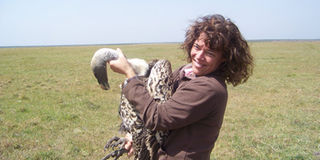Study tracks movement of two vultures across Kenya borders

Darcy Ogada holding an adult Ruppell’s vulture. In the past, the cliff-nesting Rüppell’s vultures preferred feeding in groups called wakes, with a single wake numbering more than 100 individuals. PHOTO | COURTESY | OL PEJETA CONSERVANCY
What you need to know:
- The two vultures moved from Laikipia’s Ol Pejeta Conservancy to as far as Southern Ethiopia.
- The study tracks the movements of these noble birds to map out the areas of known threats and active colonies and roost sites.
- The data revealed that vultures focused on the immense wildebeest herds only during the dry season.
- Ol Pejeta Conservancy expressed its worries on the vultures’ future since the wakes are getting smaller by the day.
Two vultures tagged between February and June 2014 have covered a total of 166,500 square kilometres from Laikipia’s Ol Pejeta Conservancy to as far as southern Ethiopia.
The first Rüppell’s vulture, aged one and a half years and tagged at Ol Pejeta in February 2013, has so far covered a record area of 144,000 square kilometres, travelling to as far as southern Ethiopia.
The second bird, tagged in June 2013, is an adult aged approximately five years and is breeding about 17 kilometres northeast of Maralal, with its range being approximately 22,500 square kilometres mostly in the regions of Laikipia, Lewa, Samburu and Maralal, with a few jaunts to Baragoi and the east side of Lake Turkana.
EXHAUSTIVE STUDY
The details are contained in an exhaustive study of vultures, popularly referred to as the "cleaning crew", initiated by the Peregrine Fund in collaboration with the Ol Pejeta Conservancy and funded by the National Geographic Society and the US-based Chester Zoo targeting Rüppell’s vultures in northern Kenya.
The study tracks the movements of these noble birds to map out the areas of known threats and active colonies and roost sites in northern Kenya using GPS-GSM transmitters that are attached on their backs.
These transmitters send real-time location data, elevation, speed and direction of travel via a cell phone network once every 15 minutes.
“By mapping areas of high use by Rüppell’s vultures, we hope to provide the information needed to make management decisions regarding the protection of important nest and roost sites,” said the report.
The study began as ardent bird lovers in Kenya called on pastoralists in semi-arid and arid areas to stop putting highly lethal pesticide on cattle carcasses to trap lions and leopards, saying this was killing vultures.
VULTURE POPULATIONS
In a campaign aimed at reviving vulture populations across the country, the Africa programmes director for the Peregrine Fund, Mr Munir Virani, said vultures were extremely susceptible to poisoning, which often occurs when ranchers put pesticides on the carcasses of animals killed by lions or hyenas.
To prepare the report, entitled Drought and Drowning Equal Vulture Supermarket, researchers attached GSM-GPS telemetry devices to three species of vultures in the Mara-Serengeti ecosystem of East Africa. The devices sent text messages back to the researchers, detailing individual birds' locations and altitude.
The data revealed that vultures focused on the immense wildebeest herds only during the dry season, when hundreds of wildebeest die each day from starvation or drowning during their dangerous river crossings.
“Our study shows that vultures seek out areas with a high number of livestock in the semi-arid and arid areas, where they (livestock) are most likely to die and hence become a vulture’s supermarket for beef,” said the lead author, Dr Corinne Kendall.
REIGNS IN THE SKYS
The Ol Pejeta Conservancy said that at nine kilos, a wing span of 2.3 metres and a body covered with mottled brown-black feathers and crowned by a blue-black head and neck, the Rüppell’s vulture (Gyps rueppelli) reigns in the skies, where it rises to a record 3,685 metres above sea level.
“It is an ugly hard sell by appearance. Throw in that it is normally sighted squealing in delight as it glories in the remains of a far more elegant creature and you would be forgiven for thinking it is the ugliest creature ever created,” said the report.
Ol Pejeta said it was important to preserve vultures as man’s friend by reducing the use of toxic pesticides and acaricides that are harmful to vultures.
“These birds are nature’s garbage collectors, doing what needs to be done and getting very little credit for it.
“No sooner are the predators done feasting than a flock of vultures will descend on the meal and no one cleans up after a meal like they do.
"By eating the carcasses they not only keep the environment clean, but also act as … disease control units preventing the possible spread of disease to other animals, possibly even humans,” the report said.
FEED IN GROUPS
In the past, the cliff-nesting Rüppell’s vultures preferred feeding in groups called wakes, with a single wake numbering more than 100 individuals.
But the not-for-profit conservancy expressed its worries about the vultures’ future, since the wakes are getting smaller by the day.
Today, seven out of eight vulture species in Kenya are threatened with extinction.
“Over the last three decades their populations have been threatened by human activities such as the wanton cutting of trees and the indiscriminate use of poisons such as carbofuran, popularly known by the trade name Furadan, which take out entire wakes.
"They are hard to conserve as they scavenge beyond the realms of protected areas,” the report added.





